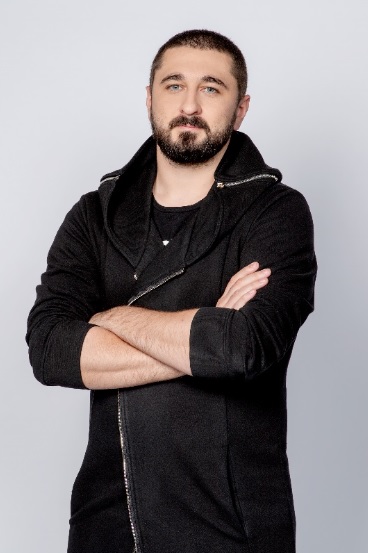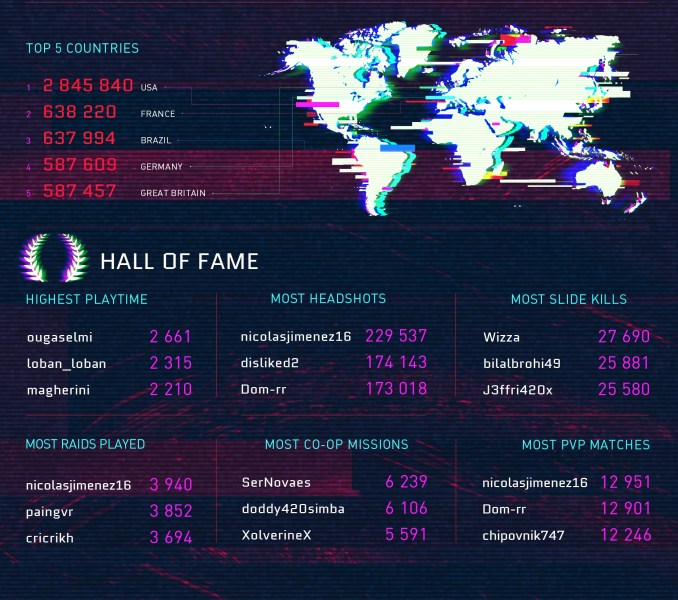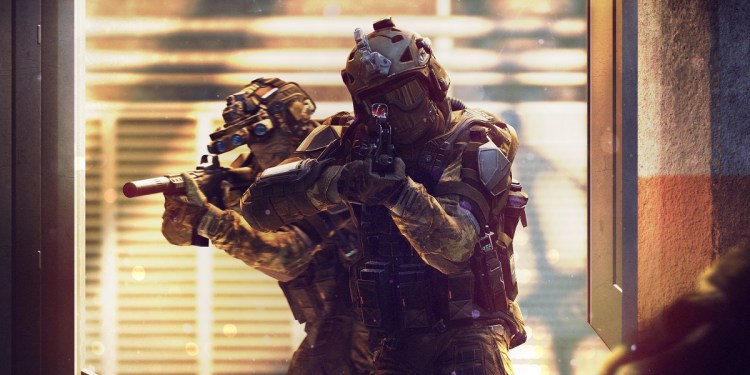My.Games‘ first-person shooter online game Warface is celebrating its first anniversary on the PlayStation 4 and Xbox One today, and the Russian company said it has 13 million players on the consoles so far.
That’s a solid addition to the Warface audience, which now numbers more than 80 million registered players. Made by Crytek Kiev, Warface first debuted as a free-to-play military combat game in 2013. Earlier this year, a team of developers from Crytek Kiev left to form Blackwood Games, which is now in charge of development for the Warface franchise.
I spoke with Ivan Pabiarzhyn, Warface franchise lead at My.Games; and Elena Grigoryan, marketing director of My.Games, about the latest on Warface. In the future, don’t be surprised to see a mobile version of Warface on iOS and Android.
Here’s an edited transcript of our interview.
June 5th: The AI Audit in NYC
Join us next week in NYC to engage with top executive leaders, delving into strategies for auditing AI models to ensure fairness, optimal performance, and ethical compliance across diverse organizations. Secure your attendance for this exclusive invite-only event.

Above: Ivan Pabiarzhyn, Warface franchise lead
Ivan Pabiarzhyn: It’s been a year since Warface launched on PS4 and Xbox One. We’re amazed by the success of the project in this new market for our team. In the first three months, we acquired around 5 million [players], and we’re still growing. At present it’s about 13 million people. We’ve experienced a lot of interesting things about the console audience, about what they want from a first-person shooter. It’s been a very valuable experience for us.
GamesBeat: How has that fit into the larger overall userbase?
Pabiarzhyn: The players coming to console were almost all new to us. They’d never played Warface on PC before. That’s been a big benefit to the franchise by itself. Talking about the total players, our player base for the franchise as a whole is around 80 million people overall, all over the globe. Console has become a way to acquire a new audience for our products. It speaks well for the community overall.
GamesBeat: How do people play? Is it on their own platforms, or do you have crossplay between console and PC?
Pabiarzhyn: Currently we don’t have crossplay, but we’ve already had some communication with the teams at PlayStation and Xbox. They’ve provided us with documentation and relationships around cross play. Next year we plan to support cross play across both consoles, across Xbox and PlayStation.
How the consoles differ
GamesBeat: As far as the different characteristics of the players on the platforms, what do you notice about the differences between PS4 and Xbox One and PC?
Pabiarzhyn: There are some differences. But our game was released in 2013 on PC, originally. We have very well-optimized system performance in the game client. It runs very well on both PlayStation and Xbox One, on the basic versions and the pro versions as well. We don’t think it has affected the experience of the player base. The gameplay is very smooth.
Talking about the console markets, the behavior between the two platforms is the same. If you compare console to PC, there are some small differences in user behavior. For example, on PC, more players — around 60 percent — prefer to play [player-vs.-player] matches. On console it’s the other way around. The players tend to prefer to play [player-vs.-environment]. The percentage is about 60 percent PvE and 40 percent PvP.

Above: Warface stats on the consoles
GamesBeat: Geographically, is there a considerable spread? I remember that Warface on PC was very strong in eastern Europe.
Pabiarzhyn: The console market has brought a lot of people from the United States. Around 40 percent of our console players are from the U.S., and we’re very pleased by that metric.
GamesBeat: What’s the most interesting data you’ve discovered from the first year of the console game?
Pabiarzhyn: Many players are focusing on the classic modes in PvP — team deathmatch, free-for-all, and storm, the objective-based mode, which is a very popular mode around the globe by itself. What’s interesting for us, though, is that many players on console are preferring to play the storyline mode, special operations. That’s been a big part of attracting a new user base over the years, and it’s also helped bring back players who’ve left the game for one reason or another. Players who’ve been gone from the game for 30 days or more, when we provide new content month by month in that mode, it’s been a good way of making the game more interesting and bringing them back each month.
GamesBeat: Do you notice, as far as monetization goes, whether any one of the platforms has done particularly well for you?
Pabiarzhyn: We can’t distinguish differences between platforms around the monetization. Everything seems very similar.
Why Warface has lasted
GamesBeat: What has helped Warface stay popular after quite a long time in the market? What do you think is still driving the game forward?
Pabiarzhyn: It’s an interesting question. Starting from 2013, we’ve had a rule across the studio. We want to provide users with new content every month. Over all the years we’ve been doing so, it’s helped us a lot. If you look at the different content inside Warface now, we have around 10 different PvP modes, 10 special operations, a lot of PvP maps. In each mode we have six or seven unique maps, and we have more than 100 unique, real, existing weapons in the game. Every month, players can find something new to them and try it out and keep playing.
We also have a very deep achievement system inside the game. There are more than 1,000 different achievements across all kinds of content. Every time players join the game, they can set their own long-term or short-term goals and keep playing to pursue them.
Starting in 2017, we introduced the battle pass system. This was very positively received by our players, so we’re trying to provide new seasons for battle pass and combine that with new seasons of ranking matches, to provide people with different kinds of new content every season. We want to reward their participation, so every time we create new rewards — new skins, new equipment, new badges, and so on. Every time a player joins the game, they know what to do, and they have goals to work toward.

Above: Warface’s most popular playermodes
GamesBeat: Do you still identify some countries as places where Warface is the strongest, or do you feel like you have a worldwide audience now?
Pabiarzhyn: Talking about consoles, as I say, the United States is our main priority right now. A lot of people from the U.S. come into Warface each day, and we have a separate community department to talk to U.S. players and collect their feedback. We’re seeing a big impact from the western audience in general on the franchise. We’re making the western market a priority to develop the franchise worldwide.

Above: Warface in 2013
GamesBeat: How are things going on the esports front? Have you been able to measure how that impacts your user base?
Pabiarzhyn: We have a very strong esports team at the Moscow office, which helps us organize that aspect of the game. We have regular competitions in the system with several leagues — common, casual, and pro master leagues and so on. Right now we’re implementing support for the ESL IP for PlayStation. In October or November we plan to have a big tournament on PS4 with the help of the PlayStation team.
Future platforms and competition
GamesBeat: How are you thinking about future platforms? Everyone sees the new PlayStation and Xbox coming next year.
Pabiarzhyn: We’ve already started communicating with the platforms about new hardware. We’ll support both of them as we can. We’d like to keep the game on the previous versions as well, though, and make it so people from the different platforms will be able to keep playing together.
GamesBeat: What do you view as the most direct competition for you? I saw the new Wargaming project at Gamescom, which reminded me a bit of Warface.
Pabiarzhyn: We’re in a unique situation as far as competition. Warface has a very long story in the market. We have a lot of content. That’s our strongest point. Sometimes we need to release content that will let people play Warface in different ways. For example, this autumn for the PC we’re introducing a new playable [class of characters], a robot with a heavy machinegun, and in the beginning of next year we’ll have that update available on consoles as well. We’re always trying to keep updating and providing players with something new. There aren’t many titles on the market, especially free-to-play titles, that have such a strong roadmap of new content.

Above: Elena Grigoryan is marketing director for My.Games.
Elena Grigoryan: Talking about competition and different platforms as far as Warface and shooters as a genre, we believe that the shooter genre is one of the key competencies at the My.Games team. We’re very happy with the success of Warface as our key franchise in the shooter genre, but in addition to Warface we have several shooters in our lineup, for PC and console, and for mobile as well. [My.Games recently added Panzer Dogs as a studio, which is making the shooter Tacticool on mobile]. The tactical category is one of the most successful ones on mobile. We’ve been developing in the genre for many years now, and we have a lot of people who are very experienced in the genre. We’re trying to develop our competence further.
One recent step, some months ago we announced a new initiative, My.Studio, an opportunity where we’ve invited independent studios and developers to submit their ideas for developing triple-A console shooters with us. As a company, we’ve committed to finance the development of the winner of this competition and help the studio with the legal aspects, the organization aspects, and other elements of the business side, in order to let them focus on creating the game. We’re going to announce the winner late this year or in the beginning of next year.
We want to provide an opportunity for a studio that would otherwise have no way of developing their idea the way they want to. We’ll try to provide all our expertise to help them bring it to market. For now, our team is working hard to choose the best one out of all the applications we have at the current stage. We’re very pleased with the huge interest in this initiative around the world, and we’ll be happy to announce the winner very soon.
Pabiarzhyn: At My.Games we have many different studios with different kinds of experience on different platforms. That’s something we can bring to the table and share with a newcomer, to make sure that their future games will be as technologically advanced as they can be.
Ongoing development

Above: Warface on the consoles is most popular in the U.S.
GamesBeat: Where is Warface made? Is it the responsibility of a single studio in a single city, or do you have multiple studios working on it? How many people are involved, and how does it compare to some of the other shooter projects that you have going?
Pabiarzhyn: Overall we have more than 300 people working on Warface. Our main studio developing Warface, making the main content for the game, is based in Kiev, Ukraine. That studio is between 170 and 200 people right now. We have another studio based here in Moscow that focuses on the console versions. They created the console versions of the game and continue to support them. Here in Moscow there are around 30 or 40 people working on the console versions. We also have some amount of people working on content creation at our studio in Minsk, Belarus. All three teams are working as one larger team.
Starting last year and into the beginning of last year, we’ve dedicated a number of people to work on mobile as well. We have Warface mobile in development as well, and I believe the project should go live on iOS and Android next year.
GamesBeat: Do you still use the CryEngine for development?
Pabiarzhyn: For Warface on PC and consoles, yes, we’re still using CryEngine. The games engine can’t be changed over very easily. As far as our new titles, though, we’ll be using Unreal Engine 4.0. The Unreal Engine is very popular all around the globe, and there are a lot of specialists who have very good development skills in the engine. It’s especially popular here in the countries we’re based in, so we have good opportunities to hire quality engineers and developers who can help us create amazing products in the future.
The future
GamesBeat: How do you think about whether or not to replace Warface with something brand-new, versus keeping it going as it is?
Pabiarzhyn: Right now the Warface franchise is still growing on console and PC, even though the game is already eight years old. We’re growing our audience and growing our revenue. It’s still a good opportunity for us, so we want to keep the project going. We’re putting additional resources into the development of the project. We also have different plans about new projects based on the Warface franchise, though, and we’re researching that question right now.


